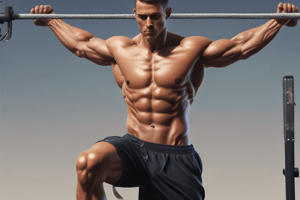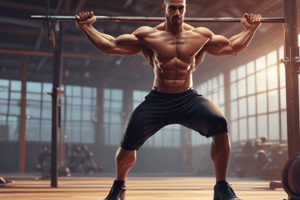Podcast
Questions and Answers
Which action involves movement using only one foot to take off and land on the same foot?
Which action involves movement using only one foot to take off and land on the same foot?
- Gallop
- Hop (correct)
- Jump
- Sway
What distinguishes a leap from a jump?
What distinguishes a leap from a jump?
- A leap covers a larger distance using one foot to take off. (correct)
- A jump only occurs in a vertical direction.
- A leap is executed using both feet to take off and land.
- A leap is a repetitive motion while jumping is not.
Which locomotor movement involves stepping to the side and then closing with the other foot?
Which locomotor movement involves stepping to the side and then closing with the other foot?
- Skip
- Gallop
- Run
- Slide (correct)
Which term refers to moving in a to-and-fro or swaying manner?
Which term refers to moving in a to-and-fro or swaying manner?
What is the primary action performed in high knees?
What is the primary action performed in high knees?
What occurs during dorsiflexion of the ankle?
What occurs during dorsiflexion of the ankle?
Which movement causes the scapula to move backward towards the midline?
Which movement causes the scapula to move backward towards the midline?
What is the primary characteristic of ipsilateral movement?
What is the primary characteristic of ipsilateral movement?
What is circumduction?
What is circumduction?
How is rotation defined in the context of movement?
How is rotation defined in the context of movement?
What is plantarflexion?
What is plantarflexion?
In which type of movement do you punch using forceful actions?
In which type of movement do you punch using forceful actions?
What type of motion does contralateral refer to?
What type of motion does contralateral refer to?
What is the correct alignment for the ankles during a bodyweight squat?
What is the correct alignment for the ankles during a bodyweight squat?
What should be the position of the lumbar during a Bend and Pull movement?
What should be the position of the lumbar during a Bend and Pull movement?
How should the knees be positioned during a Lunge and Twist exercise?
How should the knees be positioned during a Lunge and Twist exercise?
In a bodyweight squat, what is the desired position for the lead thigh?
In a bodyweight squat, what is the desired position for the lead thigh?
What is the appropriate head position during a Push Up?
What is the appropriate head position during a Push Up?
Which part of the body initiates the movement in a bodyweight squat?
Which part of the body initiates the movement in a bodyweight squat?
During a Lunge and Twist, how should the hips be aligned?
During a Lunge and Twist, how should the hips be aligned?
What indicates a stable ankle position during a bodyweight squat?
What indicates a stable ankle position during a bodyweight squat?
What is the primary movement at the hips during the described bending movement?
What is the primary movement at the hips during the described bending movement?
What position should the scapulae maintain during the pull?
What position should the scapulae maintain during the pull?
Which statement correctly describes the alignment of the knees during the movement?
Which statement correctly describes the alignment of the knees during the movement?
When performing a single leg squat, what is the correct position for the head?
When performing a single leg squat, what is the correct position for the head?
What describes the required state of the lumbar spine during the bend?
What describes the required state of the lumbar spine during the bend?
What is the characteristic of the ankles during the movement?
What is the characteristic of the ankles during the movement?
What is the definition of abduction in the context of anatomical movement?
What is the definition of abduction in the context of anatomical movement?
What role do the shoulders play during the squat?
What role do the shoulders play during the squat?
Flashcards are hidden until you start studying
Study Notes
Bodyweight Squat
- The head is centered.
- The shoulders are held down and away from the ears.
- The lumbar is in a neutral position throughout the squat.
- The movement starts at the hips, with obvious extension.
- The knees are stable and aligned with the hips and feet.
- The ankles and the feet are aligned with the knees and hips, maintaining contact with the ground.
- The balance is maintained throughout the squat.
Lunge and Twist
- The head is centered.
- The shoulders are held down and away from the ears.
- The lumbar is in a neutral position and remains stable during the squat.
- The hips are aligned horizontally and accommodate the stance width while moving.
- The knees are stable and aligned with the hips and feet.
- The ankles and feet are aligned with the knees and hips.
- The balance is maintained throughout the squat.
Single-Leg Squat
- The head is centered.
- The shoulders are held down and away from the ears.
- The lumbar is in a neutral position throughout the squat.
- The hips are aligned and extend obviously.
- The knees are stable, in line with hips and feet.
- The ankles and feet are aligned in line with the knees and hips.
- The balance is maintained throughout the squat.
Bend and Pull
- The head is centered.
- The shoulders are held down and away from the ears with hands directly beneath the shoulders.
- The lumbar is in a neutral position and remains stable throughout the movement.
- The hips are aligned with the trunk and held stable.
- The knees are held stable, and the ankles and feet are aligned.
- The balance is maintained throughout the movement.
Push-Up
- The head is centered and moves with the trunk.
- The shoulders are held down and away from the ears with the scapulae moving in a balanced and rhythmic motion. The movement starts with the scapulae in a good position.
- The lumbar is in a neutral position. The spine is not flexed during the bend or hyperextended during the stand with the arms overhead.
- The hips are aligned and do not shift left or right.
- The knees are aligned and not hyperextended.
- The ankles and feet are aligned.
Anatomical Movement and Terms
- Flexion: A movement that decreases the angle between two body parts.
- Extension: A movement that increases the angle between two body parts.
- Abduction: A movement away from the midline.
- Adduction: A movement toward the midline.
- Elevation: A movement in a superior direction, such as a shoulder shrug.
- Depression: A movement in an inferior direction.
- Pronation: A downward (posterior) movement.
- Supination: An upward (anterior) movement.
- Rotation: A movement where the limb turns around its long axis.
- Circumduction: A movement where the limb moves in a circle.
- Protraction: A movement that moves the scapula forward, and toward the side of the body.
- Retraction: A movement that moves the scapula back and toward the midline of the body.
- Ipsilateral: Same Side
- Contralateral: Opposite Side
Studying That Suits You
Use AI to generate personalized quizzes and flashcards to suit your learning preferences.




